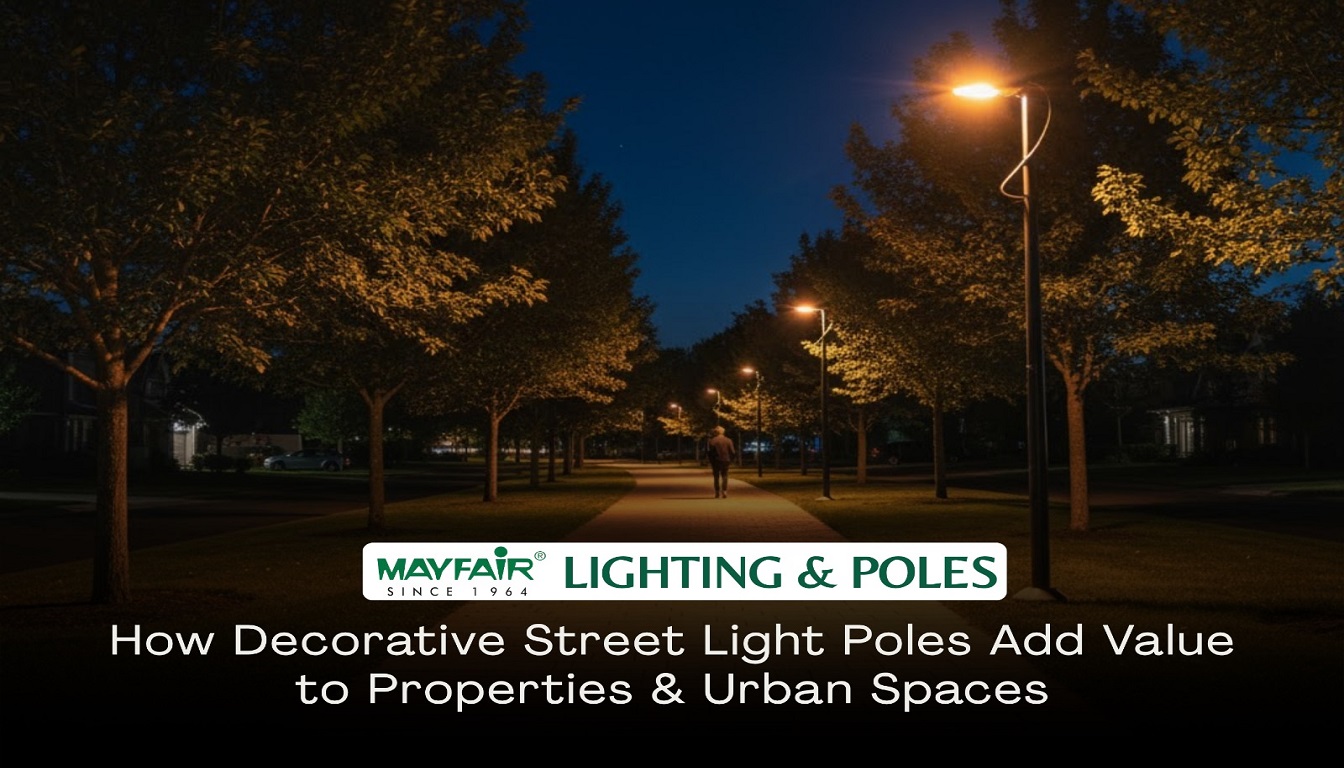
Table of Content
Imagine walking down a quiet street at dusk—the trees cast soft shadows, and the footpaths look clean and welcoming under the glow of beautiful streetlights, casting a warm glow. You feel safe. You feel proud of the neighborhood. That feeling—of quality, beauty, and care—is exactly what decorative street light poles bring. In this blog, we’ll explore how a decorative street light pole or decorative pole light isn’t just about illumination—it’s a smart investment for property projects and urban spaces.
What Are Decorative Poles & Bracket Designs?
First, a quick look at the terms:
- A decorative pole or decorative pole light is a street or pathway lighting pole designed with aesthetic features—curved arms, ornamental scrollwork, classic lamp heads, or artistic designs—instead of plain utilitarian poles.
- A bracket design is the style of the arm that sticks out from the pole to hold the light. For example, it can be a curved arm, a double arm, or a scroll-shaped arm.
- Street light manufacturers design and produce these decorative poles (and standard ones) to suit different looks, materials, heights, and durability.
- Pole design more generally refers to the shape, tapering, material, and structural aspects of the pole itself.
One prominent name in the world of decorative lighting is Mayfair Lighting known for combining style with robust engineering.
By choosing decorative over plain, you’re sending a message: this place cares about looks, quality, and identity.
Why Decorative Poles Add Real (Tangible) Value
Here are key reasons why decorative street poles boost properties value and enhance urban spaces:
- Curb Appeal & First Impressions : When buyers or visitors approach a street or development, what they see immediately influences their feeling about the place. Elegant decorative poles make streets look well-designed and classy. Lighting enhances facades, plants, signage, and landscaping after dusk. As DTE Energy notes, good outdoor lighting “makes your home look great … which increases your property value.”
- Perceived Safety & Security : People feel safer on well-lit streets. Fewer dark spots, better visibility for pedestrians and drivers, and a greater sense of active public life all lead to lower fear of crime. According to a study by Brandon Industries, neighborhoods with improved lighting see reduced crime, which in turn boosts property values.
When prospective buyers see decorative lighting in a neighborhood, they often interpret it as evidence of good maintenance, public investment, and community care. - Aesthetic Harmony & Identity : Decorative poles can be matched to architectural styles—heritage, modern, classic, or themed districts. This cohesiveness gives a sense of place and character. The aesthetic aspect of light poles is often overlooked, yet a well-designed light pole can become a visual landmark, blending function with artistic expression. Cities with strong “nightscapes” design policies emphasize lighting master plans that highlight landmarks, edges, paths, and nodes—making decorative poles part of the nighttime identity , as shown in a case study of Liepāja’s lighting master plan.
- Encouraging Night-Time Activity & Economy : A welcoming nighttime environment encourages people to walk, dine outdoors, browse shops, and linger. That increased foot traffic supports local businesses, which in turn raises the appeal and value of nearby Properties. Research shows that decorative and ambient lighting can drive night-time economic vitality, as highlighted by studies in the Eindhoven Research Portal.
- Durability, Efficiency & Low Maintenance : Many modern decorative poles are built with durable materials like cast aluminum, powder-coated steel, or corrosion-resistant alloys , which help reduce rust, maintenance costs, and repainting frequency, as noted by Special Lite Products and LightMart. Additionally, many street light manufacturers now offer LED integration, smart controls, and dimmingto reduce energy costs, which adds ongoing value and lowers operational costs for property owners or municipalities.
A Mini Case Study: Decorative Poles in Greenwich (USA)
Here’s a real-world example:
In Greenwich, Connecticut, a group of local donors funded 36 decorative light poles (worth about $252,076) to be installed along roads in the Glenville corridor. The idea was that the decorative street lights would enhance aesthetics, offer safer night driving and walking, and inject pride into the neighborhood , as reported by Greenwich Time.
The fact that residents chose to invest in decorative poles shows how people value aesthetics and safety—viewing decorative street poles not purely as cost, but as long-term value additions to urban space.
While not a full before-after property value study, this project reflects how decorative poles are used as a visible amenity in community upgrades.
How to Choose & Use Decorative Poles Wisely
To get the most benefit (and avoid pitfalls), here are best practices:
- Balance design & function: Pole design must meet lighting requirements (height, spacing, luminous intensity). The bracket design should support required lamps without over-engineering or cluttering visually.
- Follow spacing rules: As per lighting guides by the Global Designing Cities Initiative, spacing between poles should be about 2 to 3 times the height of the pole to avoid dark patches.
- Use quality materials and finishes: Powder coating, corrosion resistance, and durable metals or alloys matter in the long run.
- Integrate energy-efficient lighting: Use LED, dimming, or motion sensors to cut power use—this makes the investment more sustainable.
- Plan lighting master layouts: Work with urban lighting plans and nightscape designs so decorative poles tie into the broader scheme.
- Maintenance & monitoring: Street light manufacturers often provide guidelines and replacement parts. Regular upkeep ensures the decorations don’t degrade.
Simple Conclusion & Takeaway
Decorative street light poles are far more than ornamental—they influence how people feel, move, and invest in neighborhoods. They improve safety, boost aesthetics, and raise perceived and actual property value. When matched with smart lighting, thoughtful design, and quality materials, they become low-risk investments for urban development and real estate.
If you’re planning a new development, streetscape redesign, or public space upgrade, decorative poles should be a core feature—not an afterthought.


